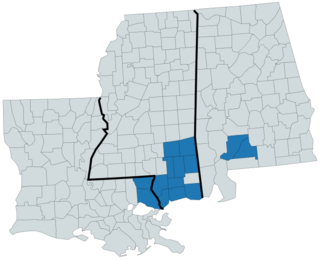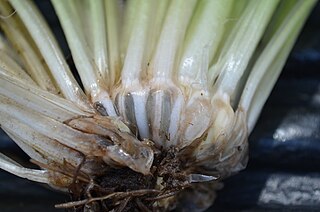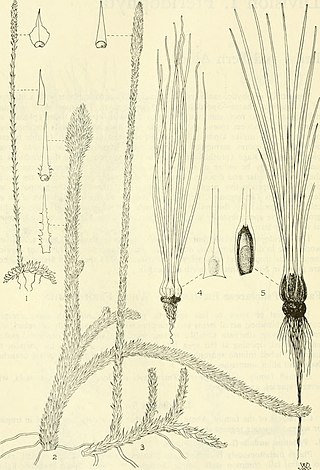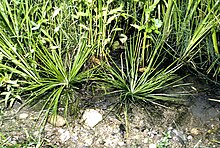
Isoetes, commonly known as the quillworts, is a genus of lycopod. It is the only living genus in the family Isoetaceae and order Isoetales. There are currently 192 recognized species, with a cosmopolitan distribution mostly in aquatic habitats but with the individual species often scarce to rare. Some botanists split the genus, separating two South American species into the genus Stylites, although molecular data place these species among other species of Isoetes, so that Stylites does not warrant taxonomic recognition. Species virtually identical to modern quillworts have existed since the Jurassic epoch, though the timing of the origin of modern Isoetes is subject to considerable uncertainty.

A marsh is — according to ecological definitions — a wetland that is dominated by herbaceous rather than woody plant species. More in general, the word can be used for any low-lying and seasonally waterlogged terrain. In Europe and in agricultural literature low-lying meadows that require draining and embanked polderlands are also referred to as marshes or marshland.

Isoetes louisianensis, the Louisiana quillwort, is a small, grass-like aquatic plant of the family Isoetaceae. It is "one of the rarest quillworts in North America." It occurs in only five locations in St. Tammany and Washington Parishes of Louisiana, as well as some spots in southern Mississippi and south-central Alabama. It is federally listed as an endangered species, partly due to its highly restricted range.

Isoetes lacustris, the lake quillwort or Merlin's grass, is a boreal quillwort native on both sides of the northern Atlantic Ocean. Synonyms include Isoetes hieroglyphica.
Isoetes histrix, the land quillwort, is an aquatic pteridophyte native to the Mediterranean region, northwestern Africa, and the coasts of western Europe northwest to Cornwall. It occurs mainly in temporarily wet habitats, otherwise called vernal pools.
Pleuromeia is an extinct genus of lycophytes related to modern quillworts (Isoetes). Pleuromeia dominated vegetation during the Early Triassic all over Eurasia and elsewhere, in the aftermath of the Permian–Triassic extinction event. During this period it often occurred in monospecific assemblages. Its sedimentary context in monospecific assemblages on immature paleosols, is evidence that it was an opportunistic pioneer plant that grew on mineral soils with little competition. It spread to high latitudes with greenhouse climatic conditions.
Isoetes appalachiana, commonly known as the Appalachian quillwort, is an aquatic pteridophyte that is widely distributed in the eastern United States. It is most frequently encountered in wetlands at low to middle elevations of the Appalachian Mountains in Pennsylvania, though its range extends from there south to Florida and Alabama along the eastern slopes of the mountains. It is a tetraploid and is grouped in the Isoetes engelmannii complex.
Isoetes valida, commonly known as the strong quillwort or true quillwort, is an aquatic lycophyte native to eastern North America. It is found primarily in the Appalachian Mountains from Pennsylvania south to Alabama and Georgia. In addition, one collection of the plant was made in a railway ditch in Wilmington, Delaware in the 1860s, but this was most likely an accidental introduction.

Isoetes tegetiformans, commonly known as mat-forming quillwort or mat-forming Merlin's grass, is an aquatic lycophyte endemic to the U.S. state of Georgia. It grows exclusively in shallow, temporary pools on granite outcrops, often with only 2 cm of soil. Only 7 populations are known to exist, and three of these have been destroyed since the plant's discovery in 1976. The remaining populations are threatened with habitat destruction due to quarrying, though the species is protected under the U.S. Endangered Species Act. New leaves quickly sprout after fall and winter rains, but during the dry summer months these typically shrivel.

Isoetes melanospora, commonly known as black-spored quillwort or black-spored Merlin's grass, is a rare and endangered aquatic lycophyte endemic to the U.S. states of Georgia and South Carolina.
Isoetes howellii, or Howell's quillwort, is a species of quillwort, a type of lycophyte. It is an aquatic plant native to North America.
Isoetes eludens is an aquatic plant in the genus commonly known as quillwort that is native to the Kamiesberg Mountains in Namaqualand, South Africa. So far it is known to grow only in a single !gau (gnamma), a small temporary pool formed in a hollowed out area of granite rock. It has likely been growing in that region for millions of years, but was only discovered in 2007 and described in 2009. The specific epithet eludens refers to the fact that it eluded discovery, in spite of several searches in recent years in the area for new quillwort species.
Isoetes caroliniana, common name Carolina quillwort, is a wetlands plant native to the mountains of Tennessee, North Carolina, Virginia and West Virginia. It is an emergent plant found in lakes and bogs. It is closely related to I. georgiana but can be distinguished by its unpigmented sporangium wall.

Isoetes echinospora, also known as spiny quillwort, spiny-spored quillwort or spring quillwort is a species of quillwort in the Isoetaceae family, and is the most abundant species in Canada. It can be found in shallow aquatic environments from Labrador and Newfoundland to Alaska, and south to Pennsylvania, Wisconsin, Michigan, Colorado, and California. In Germany it is found in only two locations: the Feldsee and Lake Titisee, both in the High Black Forest.
Isoetes acadiensis, the Acadian quillwort is a species of quillwort in the Isoetaceae family described by Kott in 1981. It can be found along the shores of lakes, ponds, and rivers in Newfoundland, Nova Scotia, and New Brunswick, as well as in the American states Maine, Massachusetts, and New Hampshire. It has a similar distribution to that of I. tuckermanii. It bears 9 to 35 mostly recurved leaves, each 5–21 cm long. The leaves are usually dark green, though can occasionally be tinged with red. The sporangium can be up to five millimeters long and 3 millimeters in length, covered one sixth to one third by the velum. The spherical megaspores are 400-570 micrometers in diameter, and bear smooth ridges. The kidney shaped microspores are 25 to 30 micrometers long. It was originally believed to be a member of Isoetes hieroglyphica because of their similar megaspore structure.
Appalachian quillwort is a common name for several plants and may refer to:

Warnstorfia exannulata is a leafy branching wetland moss in the genus Warnstorfia within the family Amblystegiaceae and class Bryopsida. This bryopsida moss is also known as ringless-hook moss or Warnstorfia moss. It is the most common species of the genus in wetland environments and can be difficult to distinguish from others within the genus. It grows in acidic soils like fens and bogs, or in freshwater pools and lakes.

Isoetes mississippiensis, the Mississippi quillwort, is a small aquatic pteridophyte from the family Isoetaceae.

Isoetes melanopoda is a species of nonflowering vascular plant belonging to the quillworts in the family Isoetaceae. Its common names include: black-footed quillwort, midland quillwort, and prairie quillwort.
Isoetes stephanseniae, the granite quillwort, is a species of quillwort from South Africa, named for A. J. Stephansen, who discovered it in 1927. Of very limited distribution, it is known to survive only as one population in seasonal pools over granite near Stellenbosch, where it is threatened by the encroachment of alien species and eutrophication from the sewage works on whose grounds it grows. Like other quillworts, it bears a tuft of leaves with distinctively sculpted megaspores. It is most similar to Isoetes capensis, the cape quillwort, which occurs in the same province; both hold their leaves at a 45-degree angle, unlike most South African quillworts which have leaves stiffly erect.










